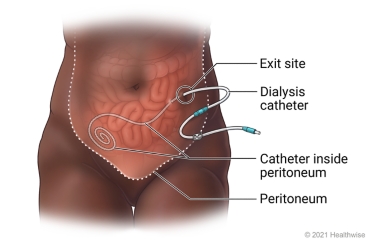Peritoneal Dialysis Catheter Placement: What to Expect at Home

Your Recovery
Peritoneal dialysis catheter placement is a surgery to place a soft tube (catheter) in an area of your belly (peritoneum) for dialysis. Dialysis does the work of your kidneys when they fail.
Your doctor made a small cut (incision) in your belly. Then your doctor placed a catheter through the cut and into your belly. The cut was closed with stitches. The end of the catheter exits out of your belly or your doctor may leave it under your skin for now (buried), until it is time to start dialysis.
Within a few months after your catheter placement, you'll start dialysis. Dialysis fluid will flow into your belly through the catheter. It stays there for several hours. Then it flows out of your belly through the catheter.
Keep the bandage around the catheter dry, and don't take it off. Be careful not to bump or move the catheter.
You may have some pain for a few days. You may also feel tired and sick to your stomach. Be sure to rest when needed. And follow your doctor's instructions for how to manage your pain and nausea.
This care sheet gives you a general idea about how long it will take for you to recover. But each person recovers at a different pace. Follow the steps below to get better as quickly as possible.
How can you care for yourself at home?
 Activity
Activity
- Do not lift heavy objects.
- Limit physical activity. Ask your doctor when it's okay to do your normal activities.
- Do not swim until your doctor says it's okay.
 Diet
Diet
- Avoid constipation and straining. Your doctor may suggest fibre, a stool softener, or a mild laxative.
 Medicines
Medicines
- If you stopped taking aspirin or some other blood thinner, your doctor will tell you when to start taking it again.
 Incision care
Incision care
- You will have a dressing over the cut (incision). A dressing helps the incision heal and protects it. Do not change or care for the dressing. Dressing changes will be done by your care team until the cut heals.
- Keep the dressing clean and dry.
- Try not to bump or move the catheter until the cut heals.
 Hygiene
Hygiene
- Use a face cloth to clean your body. Be careful to not get the bandage wet.
- Do not shower until your care team has told you that your cut has healed.
- Do not take a bath, use a hot tub, swim, or put your cut under water until your care team tells you this is okay and shows you how to do these activities safely.
 Catheter care after the incision heals
Catheter care after the incision heals
- Always wash your hands before and after you touch the catheter.
- Clean your catheter site daily. Your care team will show you how to do this. Pat dry with a clean towel.
- Your doctor may tell you to apply ointment to clean the skin around the catheter. Your care team will tell you what ointment to use and how to apply it. Replace with a clean dressing.
- Always clean and dry your catheter and access area right away after you get wet.
- Fasten or tape the catheter to your body to keep it from catching on your clothes.
- Never use scissors or other sharp objects around your catheter.
- Store your dialysis supplies in a cool, dry place.
Follow-up care is a key part of your treatment and safety. Be sure to make and go to all appointments, and call your doctor or nurse advice line (811 in most provinces and territories) if you are having problems. It's also a good idea to know your test results and keep a list of the medicines you take.
When should you call for help?
Call your doctor or nurse advice line now or seek immediate medical care if:
- You have symptoms of infection, such as:
- Increased pain, swelling, warmth, or redness around the cut.
- Red streaks leading from the cut.
- Pus draining from the cut.
- A fever.
- You have belly pain.
- You have nausea or vomiting.
Watch closely for changes in your health, and be sure to contact your doctor or nurse advice line if:
- The dialysis fluid looks cloudy or is a different colour.
- Fluid does not flow through the catheter.
- The dialysis equipment isn't working.
Where can you learn more?
Go to https://www.healthwise.net/patientEd
Enter P012 in the search box to learn more about "Peritoneal Dialysis Catheter Placement: What to Expect at Home".
Adaptation Date: 08/18/2022
Adapted By: Alberta Health Services
Adaptation Reviewed By: Alberta Health Services
